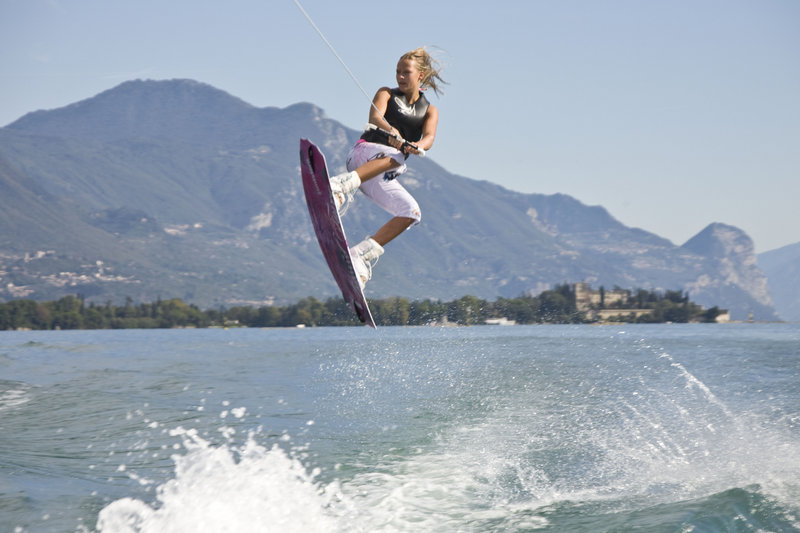As with many freestyle sports such as snowboarding and surfing, there is almost a separate language of terms to describe various tricks. The more height, the more "pop". So therefore the rider's edge is very important to the height of the jump. Heading towards the wake chest facing the boat is known as a heelside edge; approaching from the other direction with chest facing away from the boat is known as toeside edge. A typical beginner to intermediate rider will tend to have an easier time hitting the wake heelside because it tends to come more naturally to the rider. While more advance riders can hit the wake both heelside as well as toeside.
- Raley - the rider hits the wake and allows their body to swing backwards, up overhead, parallel to the water. The rider then swings the board and his or her body down and lands on the other side of the wake.
- Fakie or switch - the rider rides the board with their weak foot forward (opposite of their normal stance,i.e. If you normally ride with your left foot forward you would ride with your right foot forward).
- 911 - A raley tweaked out(shifty) with a whole ton style
- Switch air raley - the rider starts and ends an air raley in the switch position.
- Batwing - Toeside raley with Indy grab with the board perpendicular to the water as opposed to parallel.
- Butter slide - a rider approaches the wake, "snaps" the board sideways so that they can slide on top of the wake.
- Surface 360 - a rider spins the board 360 degrees while riding the surface of the water.
- Shuvit
- Tantrum - a rider back flips over the wake on an axis perpendicular to the direction of the board.
- Backroll - a rider flips (or rolls) over the wake on an axis parallel to the direction of the board, as if he/she were following it around like a continuous loop
- Frontroll - a rider flips forward (or rolls) over the wake on an axis parallel to the direction of the board.
- Boardslide - a rider approaches an obstacle and slides the board-- perpendicular with the obstacle-- along the obstacle,with the obstacle in between the rider's feet.
- Half-cab - when doing a trick from your switch stance and landing it with your regular stance.
- Tootsie Roll - Front roll to blindside 180.
- Blind Judge - Backside raley to blindside 180.
- Scarecrow - Toeside front roll with frontside 180.
- Crow Mobe - Scarecrow with an extra 180 (Frontroll with a frontside 360)
- Dev-glass - Butter slide one side of the wake and from that side jump all the way to the other side of the wake landing on a Butter slide.
- Bel Air - Tantrum without using the wake for air.
- Air Krypt - Toeside air raley with 180 degree turn, land opposite direction from take off.
- Hoochie Glide - Air Raley with method grab.
- Whirlybird - Tantrum Mobius with overhead 360 (no handle pass)
- Tweety Bird - Whirlybird without using wake for air.
- Osmosis 540 - Frontside 540 where instead of passing the handle behind the back, the rider pops the handle and catches it again upon the end of the rotation.
- Backslide Alley-Oop-Huge jump with 180 turn landing on reverse butter slide on same side of wake as you hit.
- S-bend - Heelside raley with hands overhead spinng a backside 360 horizontally
- S-Bend to Blind - Heeliside raley with handside overhead spinning a backside 360 horizontally finishing with a quick 180 with one hand behind your back
- S-Bend 720 - Heelside Raley with hands overhead spinning 2 quick backside 360 horizontally landing in triumph.
